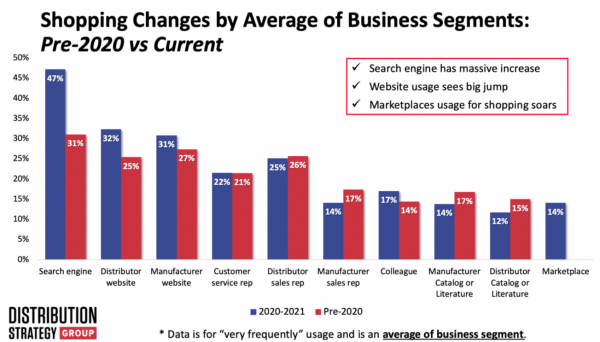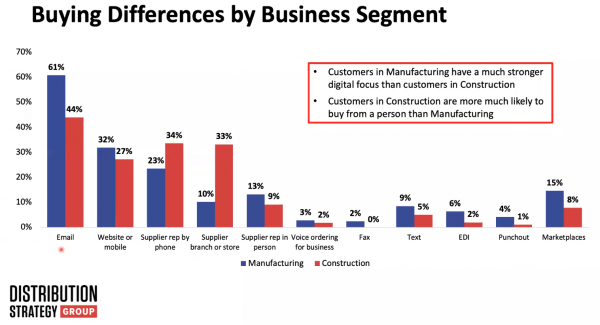Blog Post
The customer journey looks astonishingly different than what it did prior to 2020.
Shopping and buying preferences have shifted toward digital channels. We’ve long expected that… COVID just accelerated it, as well as the fact that Millennials and younger professionals are now in power-buying positions and prefer digital methods.
Now more than ever, distributors must rethink how they market and sell their products.
Recently, Distribution Strategy Group (DSG) surveyed more than 6,000 distributor customers about their shopping and buying preferences when it comes to procuring products. And the data speaks for itself.
Shopping globally
According to the survey data, 47% of surveyed respondents (across business segments) opt for a search engine to research products, while manufacturer websites and distributor websites are a distant second.
For our purposes, shopping is defined as the process a distributor customer goes through to find, research and evaluate products.

The shopping experience is what’s going to differentiate your distribution business from others. It’s here where you can deliver a cohesive, engaging customer experience and make a lasting impact.
This is why user experience is instrumental, because you lose opportunities if the customer experience isn’t what’s expected, luring them to a manufacturer’s website instead. You must provide dynamite product data, including availability, multiple images, accurate specifications and robust search functionality. Also, don’t forget about the importance of SEO, which is critical to drive traffic to your site; otherwise, even a best-in-class website will go unnoticed.
“Site search is fundamental. And having quality product data, and optimizing the search engine properly is key, because if you don’t have that, people can’t find you. Then what’s the point of doing all this? If customers need to find you through search engines, but they can’t, you miss out on an opportunity.”
Dean Mueller, Partner at Digital Strategy Group
But don’t feel like you’re facing an Amazon-sized task. To run an ecommerce strategy, you don’t need to compete with Amazon. Instead, focus on what makes your business special: those value-added services that customers don’t receive anywhere else. What are those offerings you bring as a distributor, and how can you extract them to attract and retain customers? Find that value and support it in a digital way.
Buying manually
Here’s where things get weird. Although digital channels are skyrocketing for shopping patterns among distributor customers, the #1 method of buying is email.
For our purposes, buying is defined as a distributor customer ordering, purchasing or transacting to obtain products.
For the manufacturing sector:
- 64% of respondents who shop via a search engine ultimately buy via email
- 62% of respondents who shop with a distribution sales rep also buy via email
Even when comparing by business segments, emailed orders still come out on top:
- 61% of respondents in manufacturing prefer to order by email
- 44% of respondents in construction industry order via email

“Being able to use technologies, such as email order automation or EDI, is just really critical to increase profit, decrease the time it takes to process, and remove costs associated with serving customers.”
Dean Mueller, Partner, Digital Strategy Group
The right technology can eliminate the burden of manually processing all those emailed orders. For example, the Conexiom Platform for Sales automates the documents that are received from buyers during the order-to-cash (O2C) process. Automating these key trade documents allows businesses to stay competitive in an environment of heightened B2B buyer expectations.
Actionable takeaways
The bottom line: Distributors must plan and implement a solid ecommerce offering that gets you into the digital game and keeps you in it.
-
Search engine use is obviously on the rise and will continue to grow. It’s essential to create quality product data and optimize for search engine optimization (SEO).
-
Prioritize both an online and offline customer experience (CX). Provide a robust ecommerce offering that contains in-depth product descriptions and real-time availability to keep your company winning within the digital realm.
-
Implement technology for touchless ordering, including email order automation, EDI and punchout.
-
Know your customer! What’s their journey and how does it affect their shopping and buying?
-
Differentiate your business with value-added services that customers need.
Want more insights, more data on the evolving customer journey? Watch the on-demand webinar hosted by Digital Strategy Group, “2021 State of Shopping and Buying in Distribution: Behind the Changing Customer Journey.”
